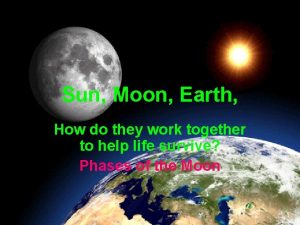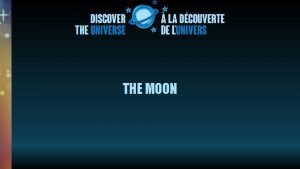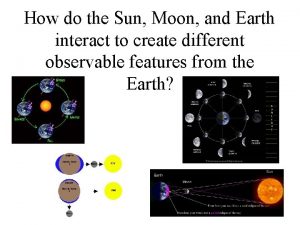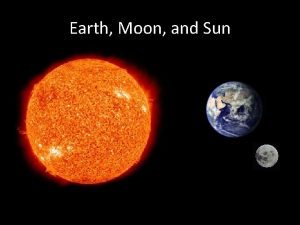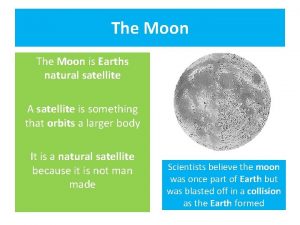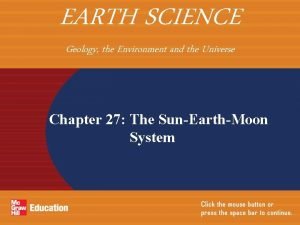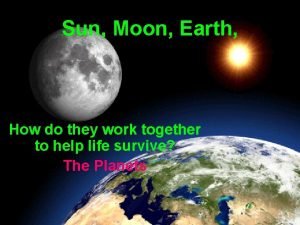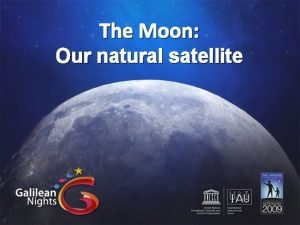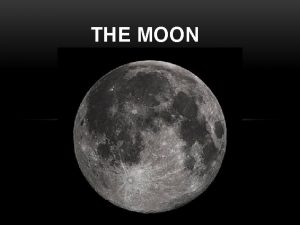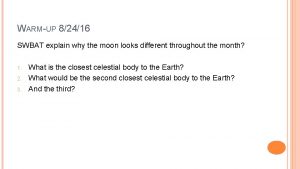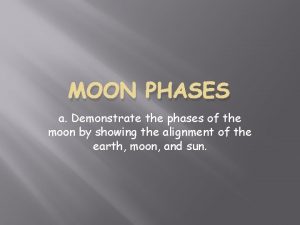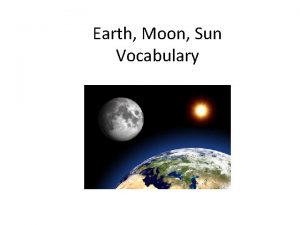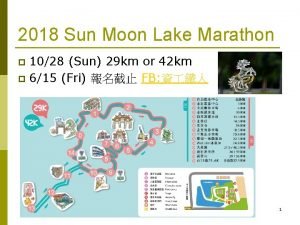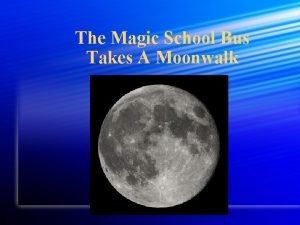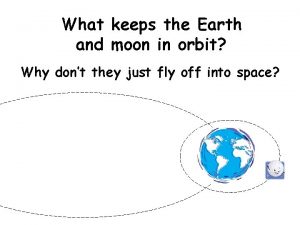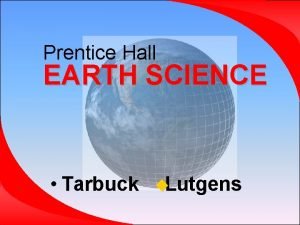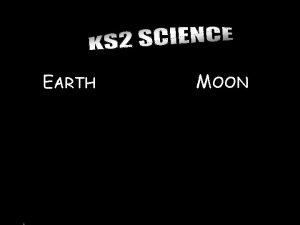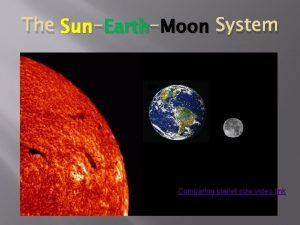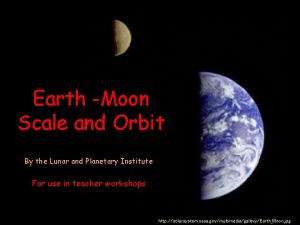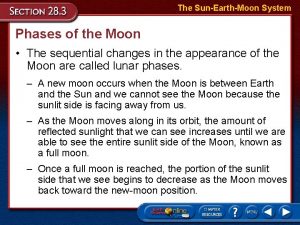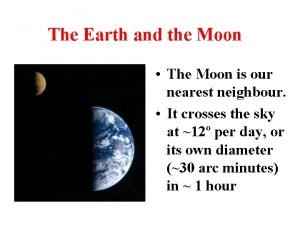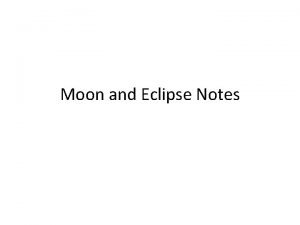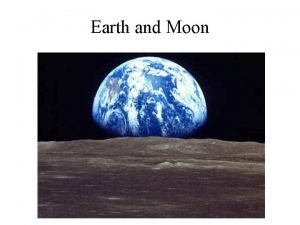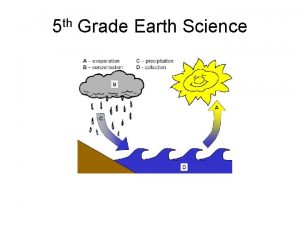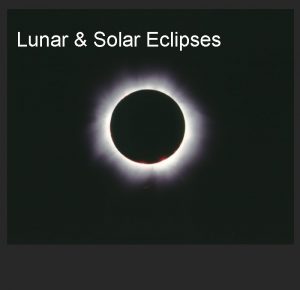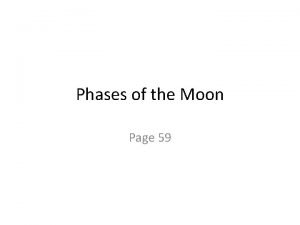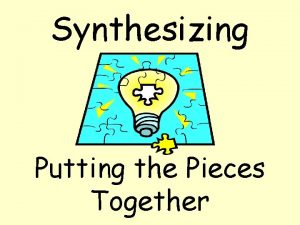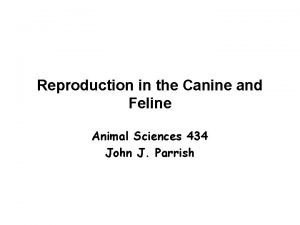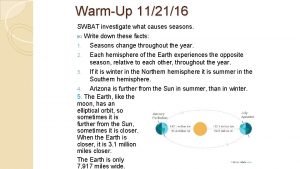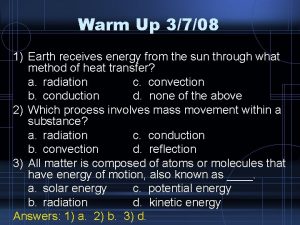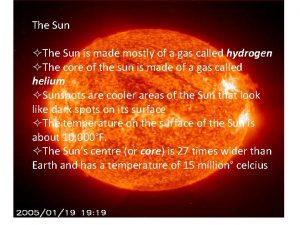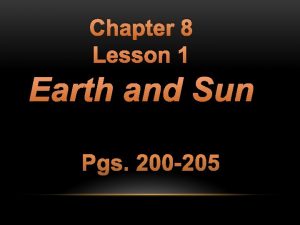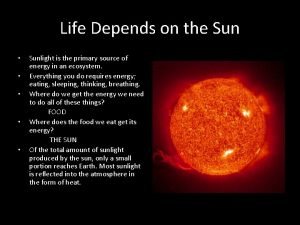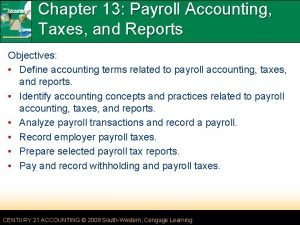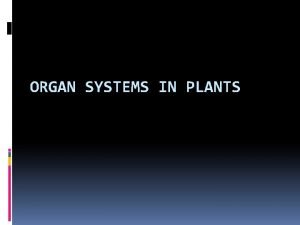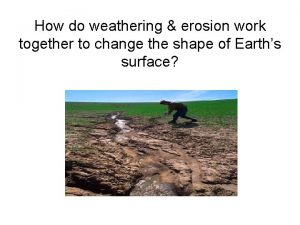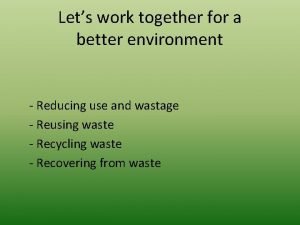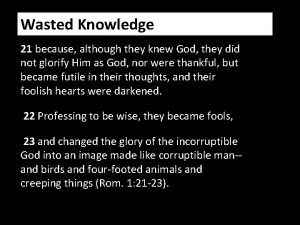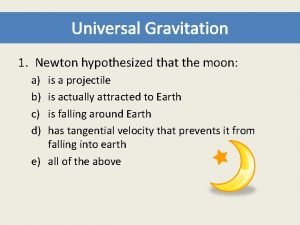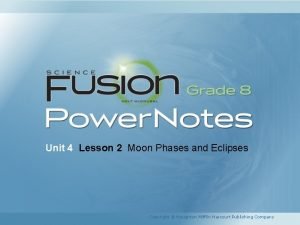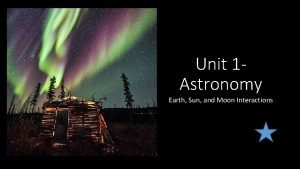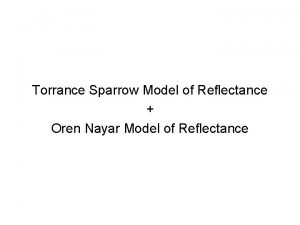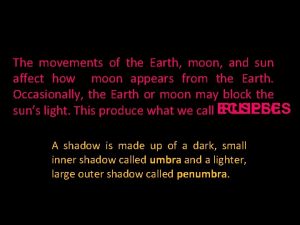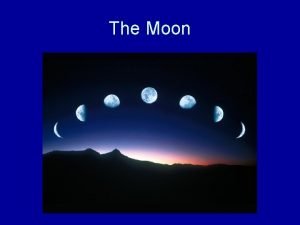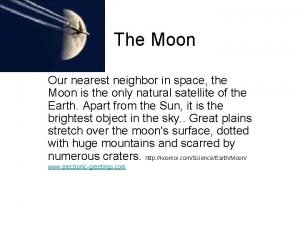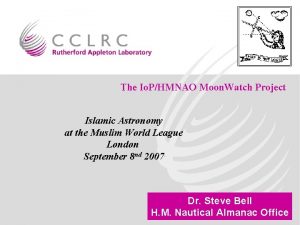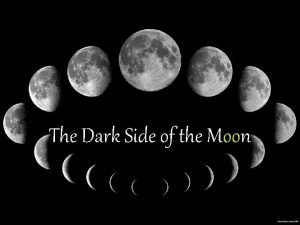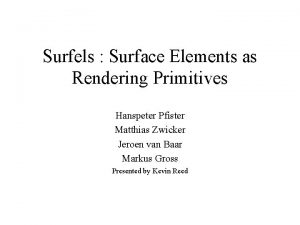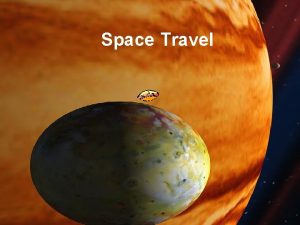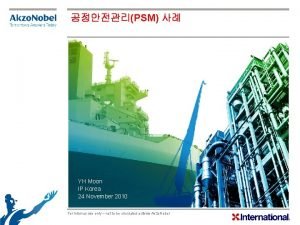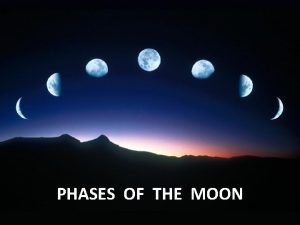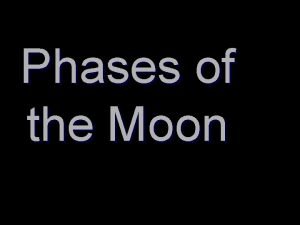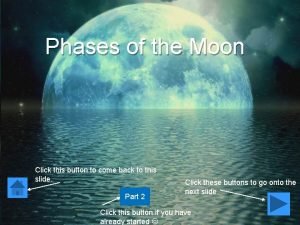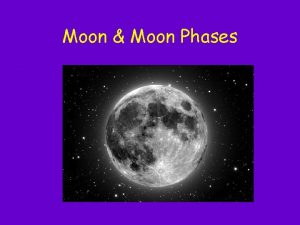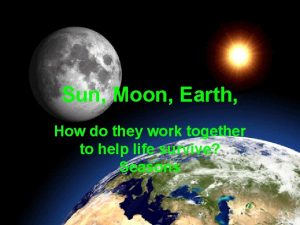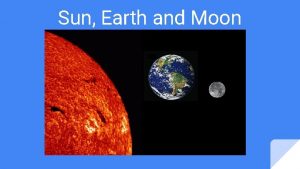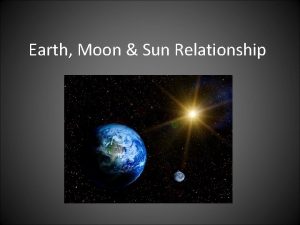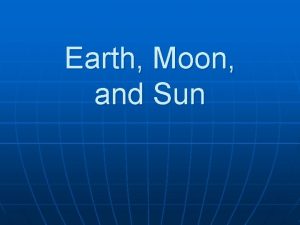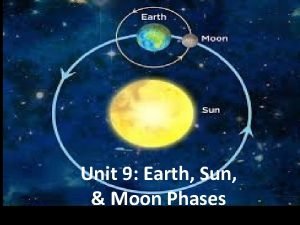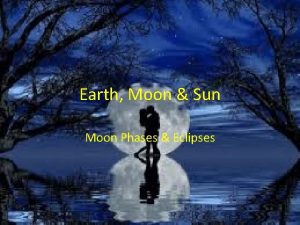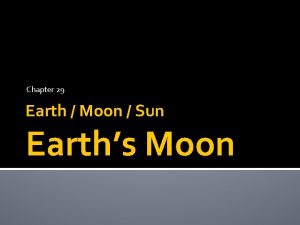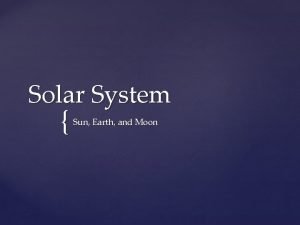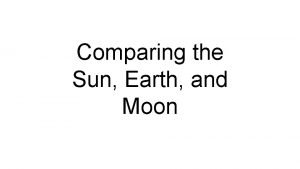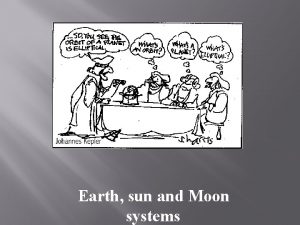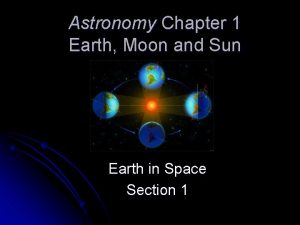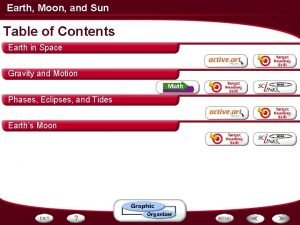Sun Moon Earth How do they work together





















































































































- Slides: 117

Sun, Moon, Earth, How do they work together to help life survive? The Planets

What is a planet? • According to the IAU (International Astronomical Union) a planet must meet these three guidelines.

What is a planet? • According to the IAU (International Astronomical Union) a planet must meet these three guidelines. 1. Is in orbit around the sun.

What is a planet? • According to the IAU (International Astronomical Union) a planet must meet these three guidelines. 1. Is in orbit around the sun. 2. Has enough mass to maintain a nearly round shape.

What is a planet? • According to the IAU (International Astronomical Union) a planet must meet these three guidelines. 1. Is in orbit around the sun. 2. Has enough mass to maintain a nearly round shape. • Called hydrostatic equilibrium.

What is a planet? • According to the IAU (International Astronomical Union) a planet must meet these three guidelines. 1. Is in orbit around the sun. 2. Has enough mass to maintain a nearly round shape. • Called hydrostatic equilibrium. 3. Has cleared the neighborhood around its orbit.

What is a planet? • Dwarf Planets:

What is a planet? • Dwarf Planets: – Must do #1 and #2.

What is a planet? • Dwarf Planets: – Must do #1 and #2. – Does not do #3.

What is a planet? • Dwarf Planets: – Must do #1 and #2. – Does not do #3. – Is not a satellite.

What is a planet? • Dwarf Planets: – – Must do #1 and #2. Does not do #3. Is not a satellite. Currently there are 5 dwarf planets: • • • Ceres (between Mars and Jupiter) Pluto Makemake Eris Haumea

Mercury:

Mercury: • Temperature range: believed to be from -184°C to 427°C

Mercury: • Temperature range: believed to be from -184°C to 427°C • Rotation time: 58. 6 Earth days.

Mercury: • Temperature range: believed to be from -184°C to 427°C • Rotation time: 58. 6 Earth days. • Orbit: 88 Earth days

Mercury: • Temperature range: believed to be from -184°C to 427°C • Rotation time: 58. 6 Earth days. • Orbit: 88 Earth days • Mass: The Earth is 18 times more massive than Mercury.

Mercury: • Temperature range: believed to be from -184°C to 427°C • Rotation time: 58. 6 Earth days. • Orbit: 88 Earth days • Mass: The Earth is 18 times more massive than Mercury. • Diameter: 4, 878 km (about 40% of the Earth’s

Mercury: • Moons: none

Mercury: • Moons: none • Water: Polar ice that never melts.

Mercury: • Moons: none • Water: Polar ice that never melts. • Atmosphere: very thin, contains H, He, O, Na, Ca, and K. Removed and replenished constantly.

Mercury: • Moons: none • Water: Polar ice that never melts. • Atmosphere: very thin, contains H, He, O, Na, Ca, and K. Removed and replenished constantly. • Gravity: 100 pounds on the Earth weighs 37. 8 pounds on Mercury.

Mercury: • Moons: none • Water: Polar ice that never melts. • Atmosphere: very thin, contains H, He, O, Na, Ca, and K. Removed and replenished constantly. • Gravity: 100 pounds on the Earth weighs 37. 8 pounds on Mercury. • Discovered: Known since ancient times.

Mercury: • Moons: none • Water: Polar ice that never melts. • Atmosphere: very thin, contains H, He, O, Na, Ca, and K. Removed and replenished constantly. • Gravity: 100 pounds on the Earth weighs 37. 8 pounds on Mercury. • Discovered: Known since ancient times. • Distance to sun: 58 million km

Venus:

Venus: • Temperature range: from 850°F to 950°F.

Venus: • Temperature range: from 850°F to 950°F. • Rotation time: 243 Earth days

Venus: • Temperature range: from 850°F to 950°F. • Rotation time: 243 Earth days • Orbit: 225 Earth days

Venus: • Temperature range: from 850°F to 950°F. • Rotation time: 243 Earth days • Orbit: 225 Earth days • Mass: The Earth is 1. 0 times more massive than Venus.

Venus: • Temperature range: from 850°F to 950°F. • Rotation time: 243 Earth days • Orbit: 225 Earth days • Mass: The Earth is 1. 0 times more massive than Venus. • Diameter: 12, 100 km

Venus: • Moons: None

Venus: • Moons: None • Water: yes

Venus: • Moons: None • Water: yes • Atmosphere: Carbon Dioxide (95%), Nitrogen, Sulfuric Acid, and trace elements.

Venus: • Moons: None • Water: yes • Atmosphere: Carbon Dioxide (95%), Nitrogen, Sulfuric Acid, and trace elements. • Gravity: 100 pounds on Earth weighs 90. 7 pounds on Venus.

Venus: • Moons: None • Water: yes • Atmosphere: Carbon Dioxide (95%), Nitrogen, Sulfuric Acid, and trace elements. • Gravity: 100 pounds on Earth weighs 90. 7 pounds on Venus. • Discovered: Known since ancient times.

Venus: • Moons: None • Water: yes • Atmosphere: Carbon Dioxide (95%), Nitrogen, Sulfuric Acid, and trace elements. • Gravity: 100 pounds on Earth weighs 90. 7 pounds on Venus. • Discovered: Known since ancient times. • Distance to sun: 108 million km

Earth:

Earth: • Temperature range: -69°C to 58°C

Earth: • Temperature range: -69°C to 58°C • Rotation time: 24 hours

Earth: • Temperature range: -69°C to 58°C • Rotation time: 24 hours • Orbit: 365. 26 days

Earth: • • Temperature range: -69°C to 58°C Rotation time: 24 hours Orbit: 365. 26 days Mass: 5. 98 X 10 kg

Earth: • • • Temperature range: -69°C to 58°C Rotation time: 24 hours Orbit: 365. 26 days Mass: 5. 98 X 10 kg Diameter: 12, 800 km

Earth: • Moons: one

Earth: • Moons: one • Water: Yes, in all forms.

Earth: • Moons: one • Water: Yes, in all forms. • Atmosphere: Nitrogen (78. 1%, 20. 9% Oxygen and trace amounts of Argon, Carbon Dioxide, Helium, Hydrogen, and Methane.

Earth: • Moons: one • Water: Yes, in all forms. • Atmosphere: Nitrogen (78. 1%, 20. 9% Oxygen and trace amounts of Argon, Carbon Dioxide, Helium, Hydrogen, and Methane. • Distance to sun: 150 million km

Mars:

Mars: • Temperature range: -220°F to 60°F.

Mars: • Temperature range: -220°F to 60°F. • Rotation time: 24 hours 37 minutes.

Mars: • Temperature range: -220°F to 60°F. • Rotation time: 24 hours 37 minutes. • Orbit: 687 Earth days

Mars: • Temperature range: -220°F to 60°F. • Rotation time: 24 hours 37 minutes. • Orbit: 687 Earth days • Mass: The Earth is 9. 3 times more massive than Mars.

Mars: • Temperature range: -220°F to 60°F. • Rotation time: 24 hours 37 minutes. • Orbit: 687 Earth days • Mass: The Earth is 9. 3 times more massive than Mars. • Diameter: 6, 796 km

Mars: • Moons: two (Phobos and Deimos

Mars: • • Moons: two (Phobos and Deimos Water: Two permanent polar ice caps

Mars: • • • Moons: two (Phobos and Deimos Water: Two permanent polar ice caps Atmosphere: Carbon dioxide (95%), , Nitrogen, Argon, Oxygen, and trace water vapor and carbon monoxide.

Mars: • • Moons: two (Phobos and Deimos Water: Two permanent polar ice caps Atmosphere: Carbon dioxide (95%), , Nitrogen, Argon, Oxygen, and trace water vapor and carbon monoxide. Gravity: 100 pounds on the Earth weighs 37. 7 pounds on Mars.

Mars: • • • Moons: two (Phobos and Deimos Water: Two permanent polar ice caps Atmosphere: Carbon dioxide (95%), , Nitrogen, Argon, Oxygen, and trace water vapor and carbon monoxide. Gravity: 100 pounds on the Earth weighs 37. 7 pounds on Mars. Discovered: Known since ancient times.

Mars: • • • Moons: two (Phobos and Deimos Water: Two permanent polar ice caps Atmosphere: Carbon dioxide (95%), , Nitrogen, Argon, Oxygen, and trace water vapor and carbon monoxide. Gravity: 100 pounds on the Earth weighs 37. 7 pounds on Mars. Discovered: Known since ancient times. Distance to sun: 228 million km.

Jupiter:

Jupiter: • Temperature range: -163°C to 121°C.

Jupiter: • Temperature range: -163°C to 121°C. • Rotation time: 9 hours 55 minutes Earth time.

Jupiter: • Temperature range: -163°C to 121°C. • Rotation time: 9 hours 55 minutes Earth time. • Orbit: 12 Earth years

Jupiter: • Temperature range: -163°C to 121°C. • Rotation time: 9 hours 55 minutes Earth time. • Orbit: 12 Earth years • Mass: 318 times more massive than the Earth.

Jupiter: • Temperature range: -163°C to 121°C. • Rotation time: 9 hours 55 minutes Earth time. • Orbit: 12 Earth years • Mass: 318 times more massive than the Earth. • Diameter: 85, 788 miles

Jupiter: • Moons: 63 have been found with Ganymede the largest (bigger than Mercury and Pluto).

Jupiter: • Moons: 63 have been found with Ganymede the largest (bigger than Mercury and Pluto). • Water: yes

Jupiter: • Moons: 63 have been found with Ganymede the largest (bigger than Mercury and Pluto). • Water: yes • Atmosphere: Hydrogen (90%) and Helium (10%).

Jupiter: • Moons: 63 have been found with Ganymede the largest (bigger than Mercury and Pluto). • Water: yes • Atmosphere: Hydrogen (90%) and Helium (10%). • Gravity: 100 pounds on Earth weighs 236. 4 pounds here.

Jupiter: • Moons: 63 have been found with Ganymede the largest (bigger than Mercury and Pluto). • Water: yes • Atmosphere: Hydrogen (90%) and Helium (10%). • Gravity: 100 pounds on Earth weighs 236. 4 pounds here. • Discovered: Known since ancient times.

Jupiter: • • • Moons: 63 have been found with Ganymede the largest (bigger than Mercury and Pluto). Water: yes Atmosphere: Hydrogen (90%) and Helium (10%). Gravity: 100 pounds on Earth weighs 236. 4 pounds here. Discovered: Known since ancient times. Distance to sun: 778 million km

Saturn:

Saturn: • Temperature range: -178°C

Saturn: • Temperature range: -178°C • Rotation time: 10 hours, 40 minutes, and 24 seconds Earth time

Saturn: • Temperature range: -178°C • Rotation time: 10 hours, 40 minutes, and 24 seconds Earth time • Orbit: 29. 5 Earth years

Saturn: • Temperature range: -178°C • Rotation time: 10 hours, 40 minutes, and 24 seconds Earth time • Orbit: 29. 5 Earth years • Mass: 95 times more massive than the Earth.

Saturn: • Temperature range: -178°C • Rotation time: 10 hours, 40 minutes, and 24 seconds Earth time • Orbit: 29. 5 Earth years • Mass: 95 times more massive than the Earth. • Diameter: 120, 660 km (about 10 times larger than the Earth)

Saturn: • Moons: 31 including Titan, Hyperion, Mimas, Rhea, and Phoebe

Saturn: • • Moons: 31 including Titan, Hyperion, Mimas, Rhea, and Phoebe Water: yes

Saturn: • • • Moons: 31 including Titan, Hyperion, Mimas, Rhea, and Phoebe Water: yes Atmosphere: Mostly Hydrogen and Helium with some Methane and ammonia.

Saturn: • • Moons: 31 including Titan, Hyperion, Mimas, Rhea, and Phoebe Water: yes Atmosphere: Mostly Hydrogen and Helium with some Methane and ammonia. Gravity: 100 pounds on Earth weighs 106. 4 pounds on Saturn.

Saturn: • • • Moons: 31 including Titan, Hyperion, Mimas, Rhea, and Phoebe Water: yes Atmosphere: Mostly Hydrogen and Helium with some Methane and ammonia. Gravity: 100 pounds on Earth weighs 106. 4 pounds on Saturn. Discovered: Known since ancient times.

Saturn: • • • Moons: 31 including Titan, Hyperion, Mimas, Rhea, and Phoebe Water: yes Atmosphere: Mostly Hydrogen and Helium with some Methane and ammonia. Gravity: 100 pounds on Earth weighs 106. 4 pounds on Saturn. Discovered: Known since ancient times. Distance to sun: 1429 million km

Uranus:

Uranus: • Temperature range: -197. 15°C

Uranus: • Temperature range: -197. 15°C • Rotation time: 17. 24 hours Earth time (rotates clockwise)

Uranus: • Temperature range: -197. 15°C • Rotation time: 17. 24 hours Earth time (rotates clockwise) • Orbit: 84 Earth years

Uranus: • Temperature range: -197. 15°C • Rotation time: 17. 24 hours Earth time (rotates clockwise) • Orbit: 84 Earth years • Mass: 14. 5 times more massive than the Earth.

Uranus: • Temperature range: -197. 15°C • Rotation time: 17. 24 hours Earth time (rotates clockwise) • Orbit: 84 Earth years • Mass: 14. 5 times more massive than the Earth. • Diameter: 51, 500 km

Uranus: • Moons: 27

Uranus: • Moons: 27 • Water: yes

Uranus: • Moons: 27 • Water: yes • Atmosphere: 83% Hydrogen, 15% Helium, 2% Methane, and trace amounts of water and ammonia.

Uranus: • Moons: 27 • Water: yes • Atmosphere: 83% Hydrogen, 15% Helium, 2% Methane, and trace amounts of water and ammonia. • Gravity: 100 pounds on Earth weighs 88. 9 pounds on Uranus.

Uranus: • Moons: 27 • Water: yes • Atmosphere: 83% Hydrogen, 15% Helium, 2% Methane, and trace amounts of water and ammonia. • Gravity: 100 pounds on Earth weighs 88. 9 pounds on Uranus. • Discovered: Sighted in 1690 but figured out it was a planet in 1781.

Uranus: • • • Moons: 27 Water: yes Atmosphere: 83% Hydrogen, 15% Helium, 2% Methane, and trace amounts of water and ammonia. Gravity: 100 pounds on Earth weighs 88. 9 pounds on Uranus. Discovered: Sighted in 1690 but figured out it was a planet in 1781. Distance to sun: 2871 million km

Neptune:

Neptune: • Temperature range: -220°C

Neptune: • Temperature range: -220°C • Rotation time: 0. 67 Earth days

Neptune: • Temperature range: -220°C • Rotation time: 0. 67 Earth days • Orbit: 164. 8 Earth years

Neptune: • • Temperature range: -220°C Rotation time: 0. 67 Earth days Orbit: 164. 8 Earth years Mass: 17. 15 times more massive than the Earth.

Neptune: • • Temperature range: -220°C Rotation time: 0. 67 Earth days Orbit: 164. 8 Earth years Mass: 17. 15 times more massive than the Earth. • Diameter: 49, 500 km

Neptune: • Moons: 8 known

Neptune: • Moons: 8 known • Water: yes

Neptune: • Moons: 8 known • Water: yes • Atmosphere: 74% Hydrogen, 25% Helium, and 1% Methane

Neptune: • Moons: 8 known • Water: yes • Atmosphere: 74% Hydrogen, 25% Helium, and 1% Methane • Gravity: 100 pounds on Earth weighs 112. 5 pounds on Neptune.

Neptune: • Moons: 8 known • Water: yes • Atmosphere: 74% Hydrogen, 25% Helium, and 1% Methane • Gravity: 100 pounds on Earth weighs 112. 5 pounds on Neptune. • Discovered: Found in 1846.

Neptune: • Moons: 8 known • Water: yes • Atmosphere: 74% Hydrogen, 25% Helium, and 1% Methane • Gravity: 100 pounds on Earth weighs 112. 5 pounds on Neptune. • Discovered: Found in 1846. • Distance to sun: 4504 million km

Pluto:

Pluto: • Temperature range: -233°C

Pluto: • Temperature range: -233°C • Rotation time: 6. 39 Earth days

Pluto: • Temperature range: -233°C • Rotation time: 6. 39 Earth days • Orbit: 248 Earth years.

Pluto: • • Temperature range: -233°C Rotation time: 6. 39 Earth days Orbit: 248 Earth years. Mass: 0. 002 times that of Earth.

Pluto: • • • Temperature range: -233°C Rotation time: 6. 39 Earth days Orbit: 248 Earth years. Mass: 0. 002 times that of Earth. Diameter: 2, 324 km

Pluto: • Moons: One moon called Charon.

Pluto: • Moons: One moon called Charon. • Water: Unknown

Pluto: • Moons: One moon called Charon. • Water: Unknown • Atmosphere: A frozen atmosphere that melts and refreezes.

Pluto: • Moons: One moon called Charon. • Water: Unknown • Atmosphere: A frozen atmosphere that melts and refreezes. • Gravity: 100 pounds on Earth weighs 6. 7 pounds on Pluto.

Pluto: • Moons: One moon called Charon. • Water: Unknown • Atmosphere: A frozen atmosphere that melts and refreezes. • Gravity: 100 pounds on Earth weighs 6. 7 pounds on Pluto. • Discovered: Found in 1930.

Pluto: • Moons: One moon called Charon. • Water: Unknown • Atmosphere: A frozen atmosphere that melts and refreezes. • Gravity: 100 pounds on Earth weighs 6. 7 pounds on Pluto. • Discovered: Found in 1930. • Distance to sun: 5913 million km
 How does the moon earth and sun work together
How does the moon earth and sun work together How does the sun moon and earth work together
How does the sun moon and earth work together When the sun passes between the moon and earth
When the sun passes between the moon and earth The sun-earth-moon system worksheet answers lesson 1
The sun-earth-moon system worksheet answers lesson 1 What season is this
What season is this Sun moon earth relationship
Sun moon earth relationship Diagram of earth moon and sun
Diagram of earth moon and sun Whats a natural satellite
Whats a natural satellite Chapter 27 study guide the sun-earth-moon system
Chapter 27 study guide the sun-earth-moon system How the sun and moon work
How the sun and moon work Duo servicekantoor
Duo servicekantoor Which moon phase occurs directly before a new moon
Which moon phase occurs directly before a new moon Moon sister moon calendar
Moon sister moon calendar Home.hiwaay.net/ krcool/astro/moon/moon tides/
Home.hiwaay.net/ krcool/astro/moon/moon tides/ How many days for a moon cycle
How many days for a moon cycle Moon phases
Moon phases A tessellation movie
A tessellation movie Moon phases when the sun is on the left
Moon phases when the sun is on the left Does the sun and moon move
Does the sun and moon move Sun moon lake marathon
Sun moon lake marathon Moon and sun comparison
Moon and sun comparison Hudhud ni aliguyon summary
Hudhud ni aliguyon summary 14 rajlok in gujarati
14 rajlok in gujarati Personification about the moon
Personification about the moon Magic school bus moon
Magic school bus moon Moonfall msv
Moonfall msv 22.3 earth's moon
22.3 earth's moon Moon compared to earth
Moon compared to earth Earth to sun size comparison
Earth to sun size comparison Earth moon to scale
Earth moon to scale Earth moon
Earth moon Earth moon
Earth moon The different shapes of the moon you see from earth
The different shapes of the moon you see from earth Earth from moon
Earth from moon Earth from moon
Earth from moon Solar lunar eclipse
Solar lunar eclipse How far is the moon from earth
How far is the moon from earth Vragen
Vragen They leaped like deer on the moon
They leaped like deer on the moon Puts the pieces together if in use maybe
Puts the pieces together if in use maybe How long does a female dog stay in heat
How long does a female dog stay in heat What causes the seasons to change? *
What causes the seasons to change? * When earth receives energy from the sun, ____.
When earth receives energy from the sun, ____. Stopped the sun and moved the earth
Stopped the sun and moved the earth Confedency
Confedency What is the sun made of
What is the sun made of The sun warms the earth unevenly science or pseudoscience
The sun warms the earth unevenly science or pseudoscience Grade 7 term 4 natural science
Grade 7 term 4 natural science Chapter 8 lesson 1
Chapter 8 lesson 1 Does the sun rotate around the earth
Does the sun rotate around the earth Life of the sun
Life of the sun 4-1 on your own p. 97 answer key
4-1 on your own p. 97 answer key 1. 13-1 work together, p. 381
1. 13-1 work together, p. 381 Application problem 13-2 accounting
Application problem 13-2 accounting Circulatory system and respiratory system work together
Circulatory system and respiratory system work together 5-1 work together, p. 128
5-1 work together, p. 128 We are we are we are more together
We are we are we are more together Plants organs that work together
Plants organs that work together 9-4 work together
9-4 work together 6-1 work together p. 162 answers
6-1 work together p. 162 answers 6-1 work together p. 162 answers
6-1 work together p. 162 answers Dust bowl 1930s
Dust bowl 1930s Chapter 6 worksheet for a service business answers
Chapter 6 worksheet for a service business answers Application problem 8-1
Application problem 8-1 6-4 work together p. 170
6-4 work together p. 170 Cells working together form
Cells working together form Let's work together for a better future
Let's work together for a better future 7-1 work together p. 186 answers
7-1 work together p. 186 answers Blessed are the meek for they shall inherit the earth
Blessed are the meek for they shall inherit the earth Rankings: what are they and do they matter?
Rankings: what are they and do they matter? Conditional sentences exercises
Conditional sentences exercises They seek him here they seek him there
They seek him here they seek him there They have not rejected you
They have not rejected you They are they which testify of me
They are they which testify of me Grammar rules frustrate me they're not logical they are so
Grammar rules frustrate me they're not logical they are so For they not know what they do
For they not know what they do Although they knew god they did not glorify him
Although they knew god they did not glorify him How do seasons work on earth
How do seasons work on earth Jenny needs to ask me. i will buy it for her
Jenny needs to ask me. i will buy it for her Tag question exercises
Tag question exercises A company that sells
A company that sells Work immersion portfolio design
Work immersion portfolio design Important points of work immersion
Important points of work immersion Hard work vs smart work presentation
Hard work vs smart work presentation Present continuous de work
Present continuous de work Objectives of group work in social work
Objectives of group work in social work Define social casework
Define social casework Work group vs work team
Work group vs work team Physics 03-06 impulse and momentum answer key
Physics 03-06 impulse and momentum answer key Section 4 review physical science
Section 4 review physical science I work all day i work all night to pay the bills
I work all day i work all night to pay the bills Smart work vs hard work group discussion
Smart work vs hard work group discussion Compilation of work in work immersion
Compilation of work in work immersion Compare and contrast introduction example
Compare and contrast introduction example The moon and sixpence title meaning
The moon and sixpence title meaning Dua welcoming ramadan
Dua welcoming ramadan Newton hypothesized that the moon _____.
Newton hypothesized that the moon _____. Lesson 2 moon phases and eclipses answer key
Lesson 2 moon phases and eclipses answer key Oblate sheroid
Oblate sheroid Torrance-sparrow
Torrance-sparrow Position of the moon during a neap tide
Position of the moon during a neap tide School bus
School bus Umbra moon
Umbra moon During which phase of the moon do neap tides occur?
During which phase of the moon do neap tides occur? Kosmoi
Kosmoi Whats earths moon called
Whats earths moon called Moon change shape
Moon change shape Arcv11
Arcv11 Moon rotation
Moon rotation Hanspeter pfister
Hanspeter pfister Major features of moon
Major features of moon Good night rhyming words
Good night rhyming words Ip moon
Ip moon Amid this hot green glowing gloom
Amid this hot green glowing gloom Phases of the moon northern hemisphere
Phases of the moon northern hemisphere What do the phases of the moon depend on
What do the phases of the moon depend on Do we only see one side of the moon
Do we only see one side of the moon Petra moon tourism services
Petra moon tourism services

